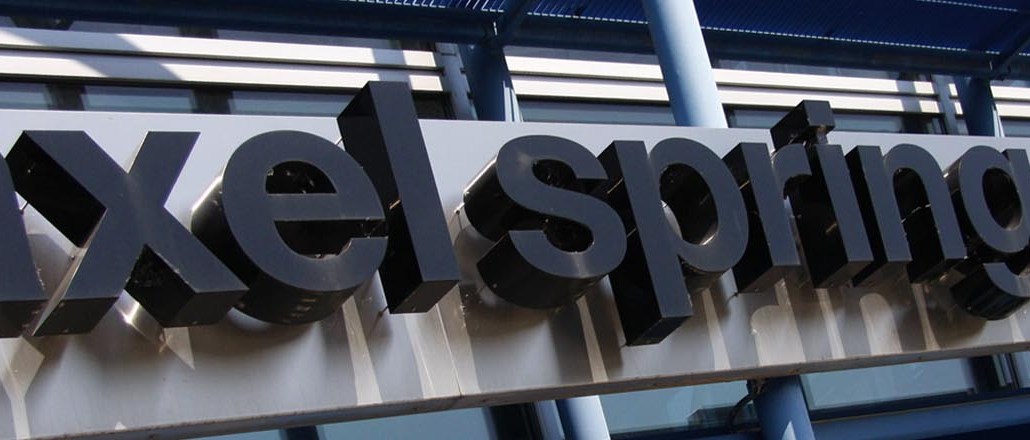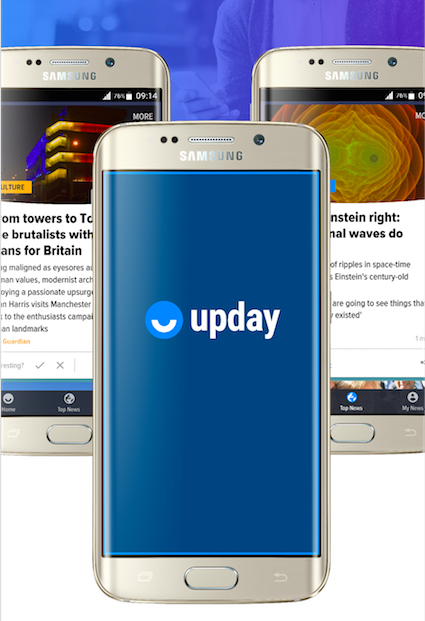Inside Axel Springer’s answer to Facebook’s Instant Articles

German publisher Axel Springer is wary of being overly dependent on third-party platforms for traffic — and is fighting back by launching its own news aggregator platform, Upday, borne out the publisher’s partnership with Samsung.
In September, Upday launched in beta and now has around 1,200 publishers on board — including The Economist, The Daily Telegraph, Le Figaro, Der Spiegel and Axel Springer publications — all eager to take a stand against platform offerings like Facebook’s Instant Articles and Apple News. During this test period, Upday claims users were spending over two hours a month using the platform.
Upday comes with a few surprises. It will be pre-installed on Samsung’s latest smartphone and tablet devices, the S7, which launch next week in the U.K., Germany, France and Poland. Users swipe right from the phone’s home screen to get to Upday, making it deeply integrated on the phone.
Former executive vice president of Axel Springer, Peter Würtenberger, and his team had approached Samsung with what they found lacking from other news aggregators. The Korean device maker made for an attractive partner: Samsung has the second-largest slice of the smartphone market in the U.K., with 32 percent, compared to Apple’s 45 percent, according to Statista. Across Europe its slice is between 40 and 50 percent, according to the publisher.
Digiday spoke with Würtenberger, CEO of Upday, about using humans and algorithms for news sourcing, creating a platform for publishers and banning ad blockers.
Humans and algorithms surface the content.
When users enter Upday (owners of older Samsung devices can download the app), publisher content is presented in the platform’s own card format, Tinder-style, and users swipe up to get to the next article. Articles are separated into “Need to Know” news, often breaking news that will be curated by a local team of journalists. Readers see between six and eight new stories each time they visit Upday, and users can opt into to get push notifications. “Want to Know” articles are sourced by an algorithm based on the preferences entered by first-time users.

“The combination of human journalists and algorithms is why Samsung came to us,” Würtenberger told Digiday. “There is no other example in the European market doing this; it distinguishes us.”
Developed with publishers in mind.
Joining aggregator platforms like Facebook Instant Articles has been a double-edged sword for publishers, gaining them audience reach but cutting them out of revenues. Axel Springer has been historically vocal on the likes of Google skimming publisher profits.
“We call it the publisher’s product, or the publisher’s platform,” said Würtenberger. It’s easy for them to get involved — Upday just takes an RSS feed. Each card carries the source of the publisher, when readers click on the card they are taken to the publisher’s Web browser, embedded in Upday’s proprietary system. This is still counted as publisher traffic. Würtenberger stressed how imported it was to link back to publisher sites since they trust the platform with its content.
Publishers will also get access to data from Upday, another boon that has meant no publisher has turned down Upday yet, according to Würtenberger.

Revenue for publishers is coming.
Springer is currently siphoning off some revenues to a royalty pool before Upday has made any money itself. Politico reports Upday will share around 5 percent of the ad revenue it makes. Würtenberger said that publishers will get some revenue kick-back depending on the country’s specific law.
“In Germany, the law is called “Leistungsschutzrecht,” (“ancillary copyright” law passed nationally in 2013, and looking to expand into the rest of the EU). It works in favor of the publishers; search engines have to give revenue to publishers they are co-operating with. I think this is fair,” said Würtenberger.
Ad blockers won’t work.
Readers cannot block ads in Upday, even when linking through to publisher sites because it’s still embedded in Upday’s proprietary system. It will feature one ad for every 10 or 20 cards, according to the publisher, and will get more targeted as Upday learns more about what its readers like. This will start off as display ads but will also include native content and video, which is to come in the next four to six weeks.
“Rule one: do not overload it with ads. Rule two: no annoying or intrusive ads. Rule three: full-page ads,” states Würtenberger. “I am not a fan of hiding advertising.”
More in Media

Publishers revamp their newsletter offerings to engage audiences amid threat of AI and declining referral traffic
Publishers like Axios, Eater, the Guardian, theSkimm and Snopes are either growing or revamping their newsletter offerings to engage audiences as a wave of generative AI advancements increases the need for original content and referral traffic declines push publishers to find alternative ways to reach readers.

The Guardian US is starting its pursuit of political ad dollars
The Guardian US is entering the race for political ad dollars.

How much is Possible’s future in Michael Kassan’s hands?
Some people in the know at Possible said they see the conference taking a bite out of Cannes’ attendance, most acutely by U.S.-based marketers who could save money by staying on this side of the Atlantic.





